Painting Time, Timelessness, and Mystery
Art lessons for kids often ask students to paint things realistically.
Whether or not this realism is stylized, it usually involves starting with an object as inspiration and then depicting that object in artful ways.
But how do you show less “realistic” subjects like
-
Timelessness, or
-
Spiritual concepts, or
-
A simultaneous depiction of the past and the future?
This is the task given to Br. Claude Lane when he was asked to depict the ascension of Christ for St. Peter’s Catholic Church in Spokane, Washington:
-
to paint both the ascension and return of Christ in the same picture, not only, but
-
to paint both events with only one picture, and
-
to paint the meaning of the events for the viewer.
Br. Claude’s solution was to paint in symbols, and to use the language of iconography. In fact, he doesn’t describe his work as painting, but as writing. Therefore, as you can imagine, if a painting is written in a symbolic language, one needs to learn the language in order to understand what is written into the picture.
Here’s the icon one sees when entering the church.
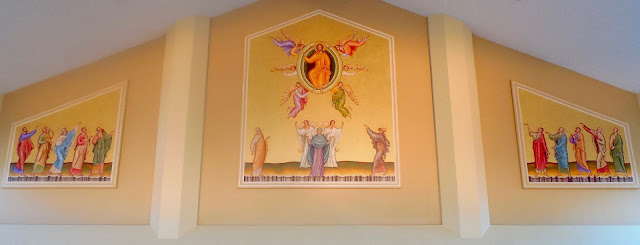
Let’s start our study of the icon at the bottom. The figures stand on a rather barren landscape at the edge of a cliff. The world depicted here is rough, imperfect, and not without its hazards.
On the left and right are ten apostles. Their figures are elongated to suggest that mankind will be greater/glorified in heaven.
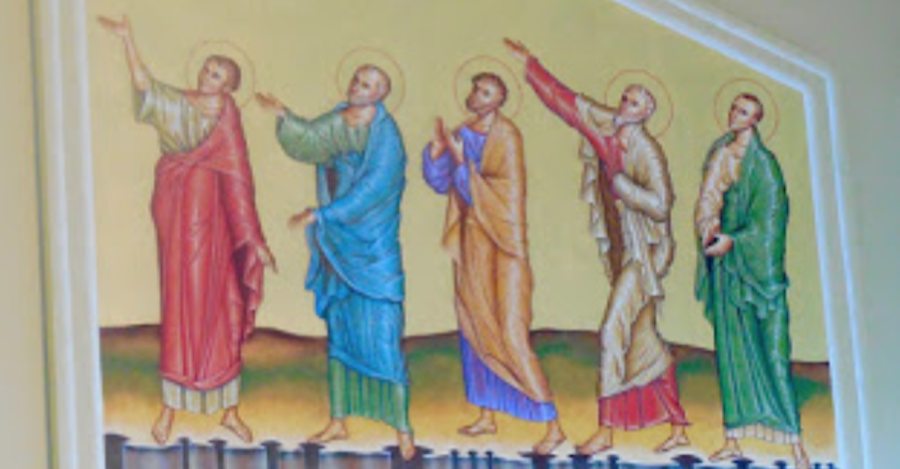
In the center is the Virgin Mary surrounded by angels. Mary, in this iconographic language, symbolizes the church. The church/Christians are always in prayer, so the figure likewise holds her hands up in prayer. The two angels beside her - angels are heaven’s messengers - are Goodness and Mercy. So with these three figures we are told the work of the church: to wait in prayer and to proclaim God’s goodness and mercy.
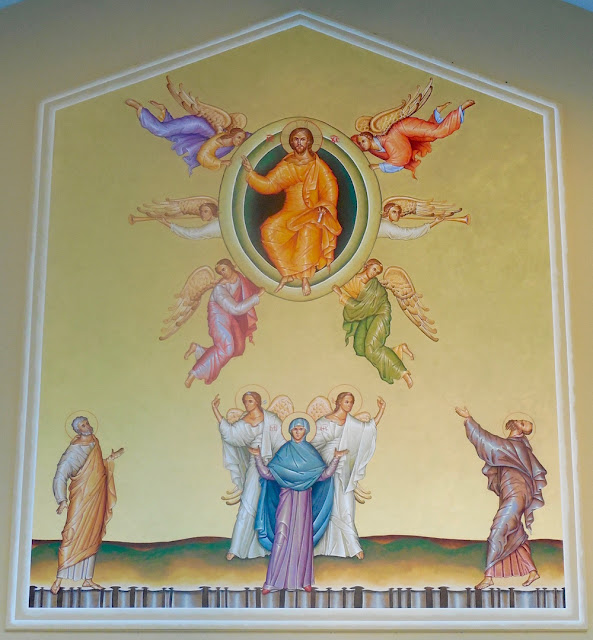
Beside the Virgin Mary are the Sts. Peter and Paul. Peter was present at the ascension, while Paul met the Lord on the way to Damascus.
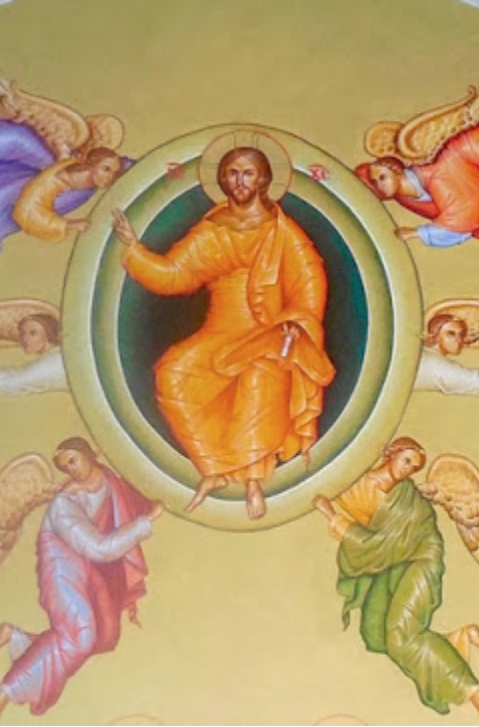
The focus of the whole icon is on the Christ figure. He is contained in an almond-shaped mandorla.
What’s a mandorla?
It’s a kind of halo, full of light, that surrounds a holy figure, often Christ.
But look! This mandorla is dark!
The closer it gets to the Christ figure, the darker it gets! This is a symbolic way of saying that the light is so bright - so great - that human eyes cannot see it. His greatness is beyond our comprehension.
The angels surrounding him are in the colors of the rainbow, and as you probably know, the rainbow is an old symbol of God’s covenant faithfulness.
The interesting thing is that you can’t tell whether the Christ figure is ascending or descending. Again, this seeming confusion is symbolic. The icon refers both to past time (the ascension) and future time (Christ’s return). The same Christ that ascended will also descend.
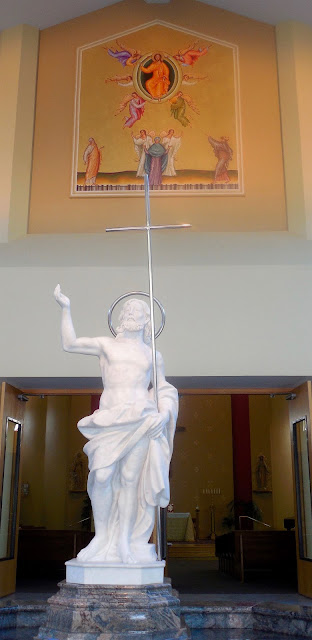
Nearer the entrance is a statue of John the Baptist. The statue’s position is significant. It stands in a baptismal pool as it points up to the Christ figure high above it. Thus it is both
-
Calling people to baptism and repentance, and
-
Pointing to Christ, whose coming John the Baptist foretold.
Again, notice how the statue tells of time past, present, and future.
There’s much more that could be said about reading the icon, but this much should at least
-
Alert you to the fact that Icons have a special language, and
-
Get you started at learning the language!
Art lessons for kids often ask students to paint things realistically.
Whether or not this realism is stylized, it usually involves starting with an object as inspiration and then depicting that object in artful ways.
But how do you show less “realistic” subjects like
-
Timelessness, or
-
Spiritual concepts, or
-
A simultaneous depiction of the past and the future?
This is the task given to Br. Claude Lane when he was asked to depict the ascension of Christ for St. Peter’s Catholic Church in Spokane, Washington:
-
to paint both the ascension and return of Christ in the same picture, not only, but
-
to paint both events with only one picture, and
-
to paint the meaning of the events for the viewer.
Br. Claude’s solution was to paint in symbols, and to use the language of iconography. In fact, he doesn’t describe his work as painting, but as writing. Therefore, as you can imagine, if a painting is written in a symbolic language, one needs to learn the language in order to understand what is written into the picture.
Here’s the icon one sees when entering the church.

Let’s start our study of the icon at the bottom. The figures stand on a rather barren landscape at the edge of a cliff. The world depicted here is rough, imperfect, and not without its hazards.
On the left and right are ten apostles. Their figures are elongated to suggest that mankind will be greater/glorified in heaven.

In the center is the Virgin Mary surrounded by angels. Mary, in this iconographic language, symbolizes the church. The church/Christians are always in prayer, so the figure likewise holds her hands up in prayer. The two angels beside her - angels are heaven’s messengers - are Goodness and Mercy. So with these three figures we are told the work of the church: to wait in prayer and to proclaim God’s goodness and mercy.

Beside the Virgin Mary are the Sts. Peter and Paul. Peter was present at the ascension, while Paul met the Lord on the way to Damascus.

The focus of the whole icon is on the Christ figure. He is contained in an almond-shaped mandorla.
What’s a mandorla?
It’s a kind of halo, full of light, that surrounds a holy figure, often Christ.
But look! This mandorla is dark!
The closer it gets to the Christ figure, the darker it gets! This is a symbolic way of saying that the light is so bright - so great - that human eyes cannot see it. His greatness is beyond our comprehension.
The angels surrounding him are in the colors of the rainbow, and as you probably know, the rainbow is an old symbol of God’s covenant faithfulness.
The interesting thing is that you can’t tell whether the Christ figure is ascending or descending. Again, this seeming confusion is symbolic. The icon refers both to past time (the ascension) and future time (Christ’s return). The same Christ that ascended will also descend.

Nearer the entrance is a statue of John the Baptist. The statue’s position is significant. It stands in a baptismal pool as it points up to the Christ figure high above it. Thus it is both
-
Calling people to baptism and repentance, and
-
Pointing to Christ, whose coming John the Baptist foretold.
Again, notice how the statue tells of time past, present, and future.
There’s much more that could be said about reading the icon, but this much should at least
-
Alert you to the fact that Icons have a special language, and
-
Get you started at learning the language!
Art lessons for kids often ask students to paint things realistically.
Whether or not this realism is stylized, it usually involves starting with an object as inspiration and then depicting that object in artful ways.
But how do you show less “realistic” subjects like
-
Timelessness, or
-
Spiritual concepts, or
-
A simultaneous depiction of the past and the future?
This is the task given to Br. Claude Lane when he was asked to depict the ascension of Christ for St. Peter’s Catholic Church in Spokane, Washington:
-
to paint both the ascension and return of Christ in the same picture, not only, but
-
to paint both events with only one picture, and
-
to paint the meaning of the events for the viewer.
Br. Claude’s solution was to paint in symbols, and to use the language of iconography. In fact, he doesn’t describe his work as painting, but as writing. Therefore, as you can imagine, if a painting is written in a symbolic language, one needs to learn the language in order to understand what is written into the picture.
Here’s the icon one sees when entering the church.

Let’s start our study of the icon at the bottom. The figures stand on a rather barren landscape at the edge of a cliff. The world depicted here is rough, imperfect, and not without its hazards.
On the left and right are ten apostles. Their figures are elongated to suggest that mankind will be greater/glorified in heaven.

In the center is the Virgin Mary surrounded by angels. Mary, in this iconographic language, symbolizes the church. The church/Christians are always in prayer, so the figure likewise holds her hands up in prayer. The two angels beside her - angels are heaven’s messengers - are Goodness and Mercy. So with these three figures we are told the work of the church: to wait in prayer and to proclaim God’s goodness and mercy.

Beside the Virgin Mary are the Sts. Peter and Paul. Peter was present at the ascension, while Paul met the Lord on the way to Damascus.

The focus of the whole icon is on the Christ figure. He is contained in an almond-shaped mandorla.
What’s a mandorla?
It’s a kind of halo, full of light, that surrounds a holy figure, often Christ.
But look! This mandorla is dark!
The closer it gets to the Christ figure, the darker it gets! This is a symbolic way of saying that the light is so bright - so great - that human eyes cannot see it. His greatness is beyond our comprehension.
The angels surrounding him are in the colors of the rainbow, and as you probably know, the rainbow is an old symbol of God’s covenant faithfulness.
The interesting thing is that you can’t tell whether the Christ figure is ascending or descending. Again, this seeming confusion is symbolic. The icon refers both to past time (the ascension) and future time (Christ’s return). The same Christ that ascended will also descend.

Nearer the entrance is a statue of John the Baptist. The statue’s position is significant. It stands in a baptismal pool as it points up to the Christ figure high above it. Thus it is both
-
Calling people to baptism and repentance, and
-
Pointing to Christ, whose coming John the Baptist foretold.
Again, notice how the statue tells of time past, present, and future.
There’s much more that could be said about reading the icon, but this much should at least
-
Alert you to the fact that Icons have a special language, and
-
Get you started at learning the language!



